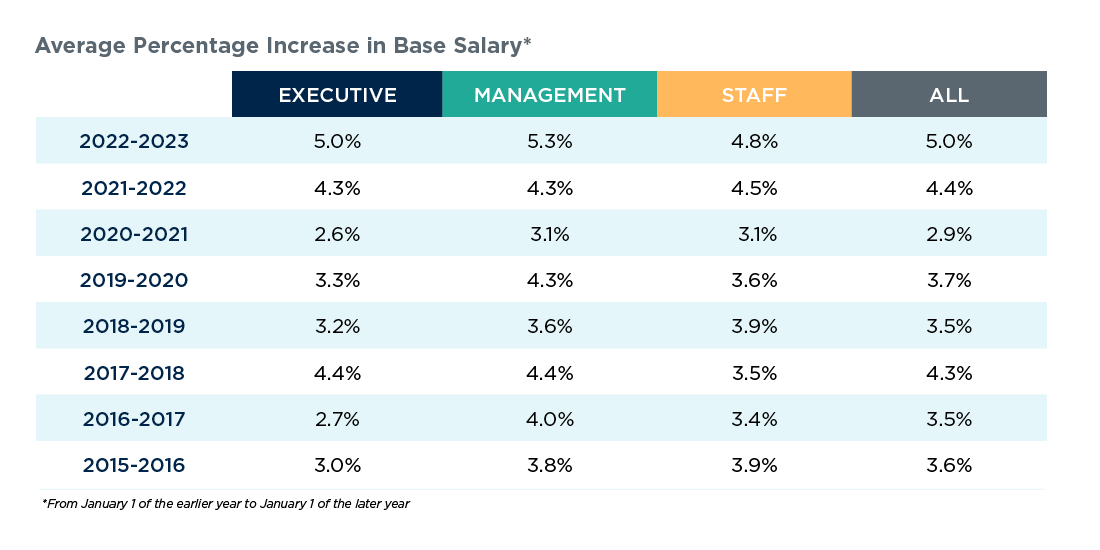Articles
Treasury and Finance Professionals’ Salaries Rise as Employers Face Talent Shortage
- By Mariam Lamech
- Published: 7/18/2023

Nearly 60% of treasury and finance functions report that they are facing a talent shortage, according to the 2023 AFP Compensation Survey.
Not only does talent scarcity impact business leaders and human resources — given the substantial time and cost it takes to hire and onboard a new employee — but it also negatively impacts existing employees. Even if they are already stretched thin, existing employees may be asked to take on additional work to cover vacant positions.
This year’s survey reflects these challenges, with 42% of respondents naming limited resources (financial, personnel, managerial) as the biggest challenge employees face right now, followed by volume of work (40%) and the recruitment of personnel (37%).
Salaries Rise in a Tight Job Market
Treasury and finance professionals’ base salaries appear to have benefited from a job market where employers have been struggling to find candidates with the necessary skills. To reduce employee turnover, many employers used raises and bonuses to incentivize employees to stay on board.
In 2022, treasury and finance professionals at all levels realized a gain in their base salaries of around 5%, the highest increase in a decade. In addition, 70% of respondents to our survey received bonus pay in 2022.

Our research suggests that the strategy of incentivizing employees through raises and bonuses works. Survey respondents at companies offering more lucrative salaries and flexible work arrangements believe these strategies helped prevent an uptick in resignations.
Other strategies that survey respondents believe will help prevent staff from resigning and mitigate challenges in filling vacant positions include:
- Recognize and reward employees (cited by 47% of survey respondents).
- Ensure staff maintain a healthy work-life balance (47%).
- Provide opportunity for upward mobility (42%).
- Offer a flexible work environment, i.e., remote or hybrid opportunities (41%).
- Provide upskilling/learning opportunities to aid in professional development (40%).
Influences on Salary
Treasury and finance professionals’ earnings are also influenced by a number of factors, including experience, education level professional certification, geographic location, industry, and organization size.
Education
Our survey indicates that in 2022 treasury and finance professionals with an MBA earned an average base salary that was approximately $19,000 higher than that of their counterparts who held only a bachelor’s degree or high school diploma/associate degree.
Certification
Treasury and finance professionals who hold a professional certification can claim prestige and credibility in their field. The Certified Treasury Professional (CTP), Certified Public Accountant (CPA) and Certified Corporate Financial Planning and Analysis Professional (FPAC) designations are among the most recognized and respected certifications in the profession. For certain job titles, incumbents who hold certifications tend to have higher salaries than those in similar positions who do not.
Region
Treasury and finance professionals’ salaries can also vary depending on the location of their organization. In examining the average base salary of finance professionals, AFP looked at the four regions of the United States (as defined by the U.S. Census Bureau) and a “virtual” region to include those respondents whose organizations are exclusively virtual. The typical treasury and finance professional in the Northeast earned the highest base salary in 2022 — a mean of $131,735 and 9% more than that earned by a peer in the Midwest ($120,852).
Industry
Over the years, the AFP Compensation Survey has revealed that average salaries vary by industry. In 2022, average base salaries ranged from $109,487 for treasury and finance professionals in the government/nonprofit sector to $134,746 in the energy/utility sector — a 19% difference.
Organization size
Organization size — as measured by annual revenue or size of workforce — also influences employees’ salaries. The survey data reveals disparities in salaries based on both annual revenue and number of employees.
In 2022, the typical treasury or finance professional at a company with annual revenue under $100 million earned an average base salary of $111,328; their counterpart at a company with at least $1 billion in annual revenue earned an average of $146,612 — a difference of 24%. There is a similar pattern when looking at organization size by number of employees. Treasury and finance professionals at organizations with 1,000 or more employees earned 14% more, on average, than their peers at organizations employing fewer than 250 employees.
Determinants of Bonuses
The organization’s performance plays a big role in determining its employees’ bonuses. Nearly 60% of respondents said their organization’s operating income or its ability to reach EBITDA (earnings before interest, taxes, depreciation, and amortization) targets determined their bonuses. The organization’s profits or increased profit targets were cited by 44% of respondents as determining bonuses. Furthermore, the completion of specific projects was cited by 40% of respondents.
Upward Mobility
Various factors influence a treasury or finance professional’s potential for promotion. The primary criterion for upward mobility is increased job responsibility (cited by 81% of respondents in this year’s survey). This figure is up two percentage points from last year’s survey, demonstrating that accepting increased job responsibility continues to be the primary factor in career growth.
Sixty-one percent of respondents noted that company growth often leads to upward mobility opportunities in their organization. Other factors impacting career advancement include:
- Contribution to department or company profitability (cited by 48% of respondents).
- Networking (20%).
- Earning an MBA or other advanced degree (11%).
- Earning a professional certification (11%).
Benefits and Leave
Almost all organizations represented in our survey offer health insurance, dental insurance and a vision plan (each cited by more than 94% of respondents). Other benefits often provided to employees are life insurance (91%), retirement/pension plans (88%) and disability insurance (82%). Though paid maternity leave is covered by 68% of organizations, only 53% of employers offer paid paternity leave.
Paid time off is another important consideration for employees evaluating a job offer. A majority of employers represented in our survey (60%) offer paid time off that includes both personal and sick-leave days. Others offer separate categories of leave — paid leave (50%) and sick leave (46%).
In this year’s survey, AFP also asked respondents about unlimited paid time off — also known as “discretionary paid time off” — a leave structure in which employees do not have a fixed number of days off. Fifteen percent of respondents said their organization offers unlimited or discretionary leave to employees.
Many organizations increase the number of days off employees receive as they gain longer tenure. For those that limit paid time off, 92% give employees five additional days of paid leave after they have been employed for a specific number of years. At 43% of organizations, employees need to be employed for at least five years to gain five additional paid days off.
Looking Ahead
Although treasury and finance professionals have received steady raises for two consecutive years, the average increase in 2022 (5%) did not match the rate of inflation, which was 6.5%. Whether the steady salary increases will continue in 2023 will depend on the economy. A downturn could undermine chances of seeing an uptick in pay, while an economy that stays on course or strengthens will bode well for compensation increases.
About the Survey
The 2023 AFP Compensation Survey was conducted in February 2023 and received responses from 1,408 treasury and finance professionals with diverse corporate profiles. The survey collected data on total compensation during the calendar year 2022 as well as data on base salaries effective January 1, 2023. Respondents shared their own salary information and some senior professionals also shared salary details for others on their team. Full survey results are available on the 2023 AFP Compensation Report page.
Copyright © 2024 Association for Financial Professionals, Inc.
All rights reserved.

